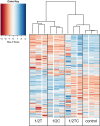Stress Resistance Development and Genome-Wide Transcriptional Response of Escherichia coli O157:H7 Adapted to Sublethal Thymol, Carvacrol, and trans-Cinnamaldehyde
- PMID: 30217837
- PMCID: PMC6210105
- DOI: 10.1128/AEM.01616-18
Stress Resistance Development and Genome-Wide Transcriptional Response of Escherichia coli O157:H7 Adapted to Sublethal Thymol, Carvacrol, and trans-Cinnamaldehyde
Abstract
Thymol, carvacrol, and trans-cinnamaldehyde are essential oil (EO) compounds with broad-spectrum antimicrobial activities against foodborne pathogens, including Escherichia coli O157:H7. However, little is known regarding direct resistance and cross-resistance development in E. coli O157:H7 after adaptation to sublethal levels of these compounds, and information is scarce on microbial adaptive responses at a molecular level. The present study demonstrated that E. coli O157:H7 was able to grow in the presence of sublethal thymol (1/2T), carvacrol (1/2C), or trans-cinnamaldehyde (1/2TC), displaying an extended lag phase duration and a lower maximum growth rate. EO-adapted cells developed direct resistance against lethal EO treatments and cross-resistance against heat (58°C) and oxidative (50 mM H2O2) stresses. However, no induction of acid resistance (simulated gastric fluid, pH 1.5) was observed. RNA sequencing revealed a large number (310 to 338) of differentially expressed (adjusted P value [Padj ], <0.05; fold change, ≥5) genes in 1/2T and 1/2C cells, while 1/2TC cells only showed 27 genes with altered expression. In accordance with resistance phenotypes, the genes related to membrane, heat, and oxidative stress responses and genes related to iron uptake and metabolism were upregulated. Conversely, virulence genes associated with motility, biofilm formation, and efflux pumps were repressed. This study demonstrated the development of direct resistance and cross-resistance and characterized whole-genome transcriptional responses in E. coli O157:H7 adapted to sublethal thymol, carvacrol, or trans-cinnamaldehyde. The data suggested that caution should be exercised when using EO compounds as food antimicrobials, due to the potential stress resistance development in E. coli O157:H7.IMPORTANCE The present study was designed to understand transcriptomic changes and the potential development of direct and cross-resistance in essential oil (EO)-adapted Escherichia coli O157:H7. The results demonstrated altered growth behaviors of E. coli O157:H7 during adaptation in sublethal thymol, carvacrol, and trans-cinnamaldehyde. Generally, EO-adapted bacteria showed enhanced resistance against subsequent lethal EO, heat, and oxidative stresses, with no induction of acid resistance in simulated gastric fluid. A transcriptomic analysis revealed the upregulation of related stress resistance genes and a downregulation of various virulence genes in EO-adapted cells. This study provides new insights into microbial EO adaptation behaviors and highlights the risk of resistance development in adapted bacteria.
Keywords: E. coli O157:H7; RNA sequencing; cross-resistance; direct resistance; essential oil adaptation.
Copyright © 2018 American Society for Microbiology.
Figures



Similar articles
-
Effects of Sublethal Thymol, Carvacrol, and trans-Cinnamaldehyde Adaptation on Virulence Properties of Escherichia coli O157:H7.Appl Environ Microbiol. 2019 Jul 1;85(14):e00271-19. doi: 10.1128/AEM.00271-19. Print 2019 Jul 15. Appl Environ Microbiol. 2019. PMID: 31076428 Free PMC article.
-
Synergism between carvacrol or thymol increases the antimicrobial efficacy of soy sauce with no sensory impact.Int J Food Microbiol. 2016 Jan 18;217:35-41. doi: 10.1016/j.ijfoodmicro.2015.10.009. Epub 2015 Oct 22. Int J Food Microbiol. 2016. PMID: 26490647
-
Use of enhanced nisin derivatives in combination with food-grade oils or citric acid to control Cronobacter sakazakii and Escherichia coli O157:H7.Food Microbiol. 2017 Aug;65:254-263. doi: 10.1016/j.fm.2017.01.020. Epub 2017 Feb 7. Food Microbiol. 2017. PMID: 28400011
-
Natural and synthetic plant compounds as anti-biofilm agents against Escherichia coli O157:H7 biofilm.Infect Genet Evol. 2021 Nov;95:105055. doi: 10.1016/j.meegid.2021.105055. Epub 2021 Aug 28. Infect Genet Evol. 2021. PMID: 34461310 Review.
-
Thymol and carvacrol supplementation in poultry health and performance.Vet Med Sci. 2022 Jan;8(1):267-288. doi: 10.1002/vms3.663. Epub 2021 Nov 10. Vet Med Sci. 2022. PMID: 34761555 Free PMC article. Review.
Cited by
-
Phytochemicals Controlling Enterohemorrhagic Escherichia coli (EHEC) Virulence-Current Knowledge of Their Mechanisms of Action.Int J Mol Sci. 2025 Jan 4;26(1):381. doi: 10.3390/ijms26010381. Int J Mol Sci. 2025. PMID: 39796236 Free PMC article. Review.
-
Structure-Dependent Inhibition of Stenotrophomonas maltophilia by Polyphenol and Its Impact on Cell Membrane.Front Microbiol. 2019 Nov 13;10:2646. doi: 10.3389/fmicb.2019.02646. eCollection 2019. Front Microbiol. 2019. PMID: 31798564 Free PMC article.
-
Carvacrol Selective Pressure Allows the Occurrence of Genetic Resistant Variants of Listeria monocytogenes EGD-e.Foods. 2022 Oct 20;11(20):3282. doi: 10.3390/foods11203282. Foods. 2022. PMID: 37431028 Free PMC article.
-
Biogenic Silver Nanoparticles Strategically Combined With Origanum vulgare Derivatives: Antibacterial Mechanism of Action and Effect on Multidrug-Resistant Strains.Front Microbiol. 2022 May 6;13:842600. doi: 10.3389/fmicb.2022.842600. eCollection 2022. Front Microbiol. 2022. PMID: 35602016 Free PMC article.
-
Polyphenolic phytochemicals as natural feed additives to control bacterial pathogens in the chicken gut.Arch Microbiol. 2022 Apr 12;204(5):253. doi: 10.1007/s00203-022-02862-5. Arch Microbiol. 2022. PMID: 35412092 Free PMC article. Review.
References
-
- Cava-Roda R, Taboada-Rodriguez A, Valverde-Franco M, Marin-Iniesta F. 2010. Antimicrobial activity of vanillin and mixtures with cinnamon and clove essential oils in controlling Listeria monocytogenes and Escherichia coli O157:H7 in milk. Food Bioproc Tech 5:2120–2131. doi:10.1007/s11947-010-0484-4. - DOI
MeSH terms
Substances
LinkOut - more resources
Full Text Sources
Other Literature Sources
Medical
Molecular Biology Databases

